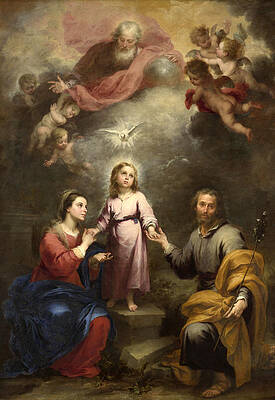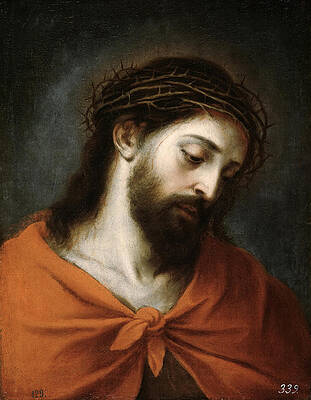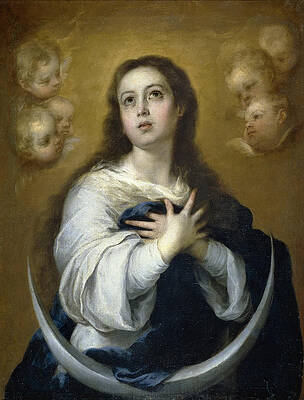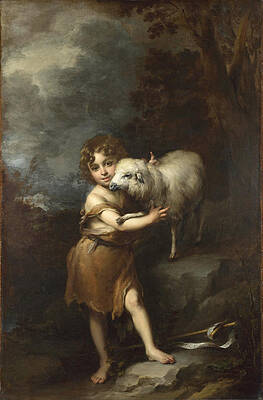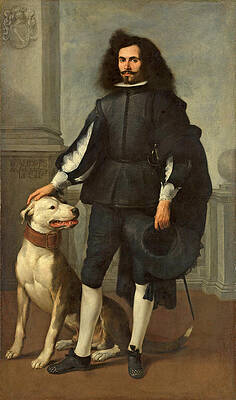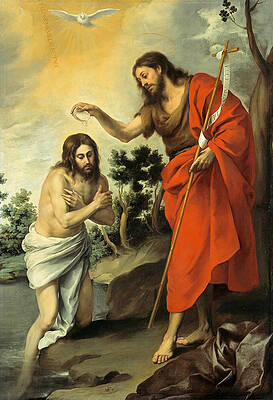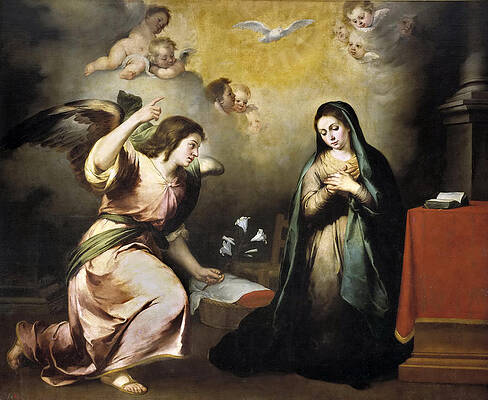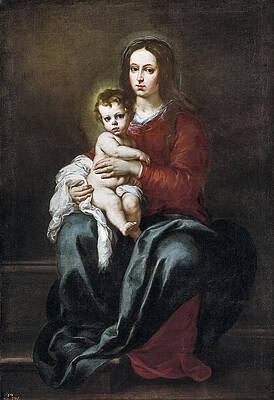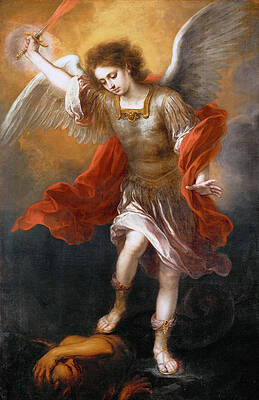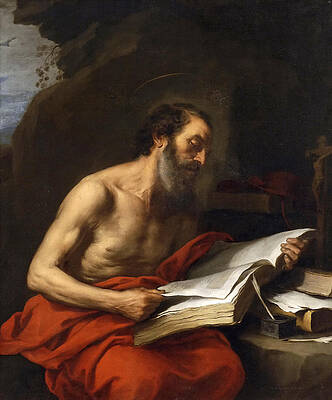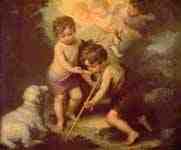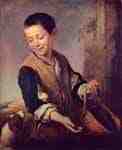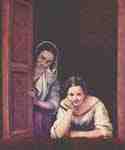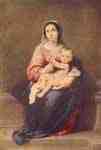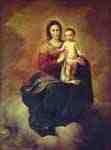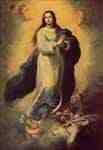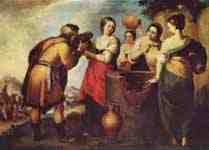Bartolomé Esteban Perez Murillo
Paintings
The Heavenly and Earthly Trinities
Ecce Homo
St. Anne teaching the Virgin to read
Christ healing the Paralytic at the Pool of Bethesda
The Good Shepherd
The Annunciation
Madonna of the Rosary
The Immaculate Conception of the Escorial
Virgin and Child in Glory
The Holy Family with a Little Bird
Saint Theresa surrounded by Angels
Four Figures on a Step
The Immaculate Conception
The Apostle Saint James
Resurrection of the Lord
The Vision to St. Francis at Porziuncola
The Crucifixion
The Immaculate Conception of Aranjuez
The Immaculate Conception
La Dolorosa
The Virgin of the Rosary
The Infant Saint John with the Lamb
Saint Bonaventura
Don Andres de Andrade y la Cal
The Nativity
The Baptism of Christ
The Birth of the Virgin
The Annunciation
The Virgin giving the Chasuble to Saint Ildefonsus
St. John the Baptist as a Child
Self Portrait
The Flight into Egypt
The Prodigal Son abandoned
The Virgin and Child
The Annunciation
Rebecca and Eliezer
Penitent Magdalen
A Peasant Boy leaning on a Sill
The Prodigal Son Receiving his Portion of the Inheritance
The Adoration of the Shepherds
Infant Christ Asleep
The Infant Christ Distributing Bread to the Pilgrims
Archangel Michael Hurls the Devil into the Abyss
The Martyrdom of St Andrew
Saint Augustine between Christ and the Virgin
Portrait of Nicolas Omasur
Saint John the Baptist in the Wilderness
Portrait of Don Justino de Neve
Laban Searching for his Stolen Household Gods
Virgin And Child
Saint Joseph with the Christ Child
Saint Peter in Tears
Saint Jerome Reading
The Conversion of Saint Paul
The Return of the Prodigal Son
The Presentation of the Virgin
Saint John the Evangelist
A Knight of Alcantara or Calatrava
Young John the Baptist
Saint Francis Xavier
The Holy Family in an interior
Virgin and Child
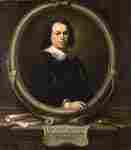

The Immaculate Conception of the Virgin

The Christ child distributing bread to the pilgrims

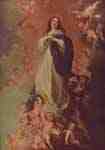
Appearance of the Immaculate Mary
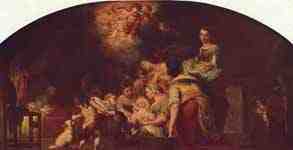
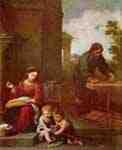
Holy Family with the Infant St. John
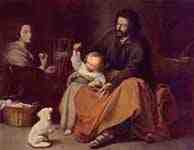 Holy Family with the Little Bird
Holy Family with the Little Bird
 Cake eater
Cake eater
 Girl with a Coin (The Galician)
Girl with a Coin (The Galician)

Abraham Receiving the Three Angels








The Blessed Giles Levitating before Pope Gregory IX

Brother Juniper and the Beggar

The Presentation of the Virgin in the Temple




Vision of St. Anthony of Padua



The Return of the Prodigal Son

The Return of the prodigal son





The two trinities (The Heavenly and Earthly Trinities)

Virgin Presenting Rosary to St. Dominic

Virgin and Child with St Rosalina of Palermo

Virgin and Child with a rosary

Virgin and Child with a rosary

Virgin and Child with a rosary

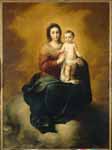









The expulsion of the prodigal son







The death of St. Clare, detail






Mary and Child with Angels Playing Music



The Mystic Marriage of St Catherine

Mystical Marriage of Saint Catherine

The Infant Jesus Distributing Bread to Pilgrims


Moses and the water from the rock of Horeb





Esquilache Immaculate Conception

The Immaculate Conception of El Escorial










Angel Rescues St. Peter from Prison


Patrician John Reveals his Dream to Pope Liberius

The Rest on The Flight into Egypt




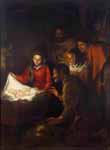
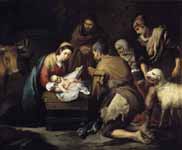


Portrait of Iñigo Melchor de Velasco, Duke of Frias
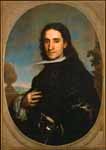

Portrait of a Gentleman in a Ruff Collar

Portrait of Joshua van Belle, merchant in Spain, mayor of Rotterdam

Portrait of don Andrés de Andrade y la Cal

Portrait of don Antonio Hurtado de Salcedo, marquis de Legarda


Invitation to the Game of Pelota

The Prodigal Son Feasting with Courtesans

The farewell of the prodigal son

The penitent St Peter kneeling before Christ at the Column




The Prodigal Son Receives his Rightful Inheritance,


Infant Christ Pricked with the Crown of Thorns


Saint Anne and Mary (Mary of Education),






The Holy Family with John the Baptist

The Holy Family with the Infant Jesus and John



The Holy Family with Saint John



St. Augustine between Christ and the Virgin

St. Augustine, washing the feet of Christ

St. Anthony with the infant Jesus

St. Leander and St. Bonaventure

Saint Didacus of Alcalá in ecstasy before the cross




St. John the Baptist as a child

Saint John the Baptist Pointing to Christ


St. Joseph and the Christ Child (with the angels in the clouds)

St Joseph Leading the Christ Child





San Salvador de Horta, and inquisitor of Aragon


Thomas of Villanova giving alms to the poors

St. Thomas of Villanueva dividing his clothes among beggar boys
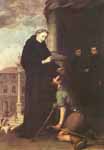
Thomas of Vilanueva heals the sick


Saint Francis of Assisi embracing the crucified Christ

Saint Francis Solanus and the Bull


Laughing boy with a feather adorned headdress


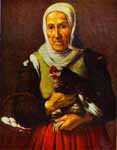




Death of the Inquisitor Pedro de Arbués

Christ In The Garden Of Olives


The Virgin Appears to Saint Bernard

The Virgin Descending to Reward Saint Ildefonso

Immaculate Conception with Six Figures
Drawings

The monk Junipero and the Beggar
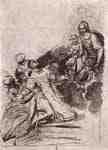
Maria with the child appears a monk

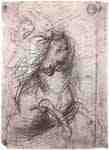
See also
After Bartolomé Esteban Murillo
Fine Art Prints | Greeting Cards | Phone Cases | Lifestyle | Face Masks | Men's , Women' Apparel | Home Decor | jigsaw puzzles | Notebooks | Tapestries | ...
Christ healing the Paralytic at the Pool of Bethesda
Bartolomé Esteban Murillo (born late December 1617, baptized January 1, 1618 – April 3, 1682) was a Spanish Baroque painter. Although he is best known for his religious works, Murillo also produced a considerable number of paintings of contemporary women and children. These lively, realist portraits of flower girls, street urchins, and beggars constitute an extensive and appealing record of the everyday life of his times.
Childhood
Murillo was born to Gaspar Esteban and María Pérez Murillo. He may have been born in Seville or in Pilas, a smaller Andalusian town.[1] It is clear that he was baptized in Seville in 1618, the youngest son in a family of fourteen. His father was a barber and surgeon. His parents died when Murillo was still very young, and the artist was largely brought up by his aunt and uncle.
Career
Murillo began his art studies under Juan del Castillo in Seville. There he became familiar with Flemish painting and the "Treatise on Sacred Images" of Molanus (Ian van der Meulen or Molano). The great commercial importance of Seville at the time ensured that he was subject to influences from other regions. His first works were influenced by Zurbarán, Jusepe de Ribera and Alonzo Cano, and he shared their strongly realist approach. As his painting developed, his more important works evolved towards the polished style that suited the bourgeois and aristocratic tastes of the time, demonstrated especially in his Roman Catholic religious works.
In 1642, at the age of 26, he moved to Madrid, where he most likely became familiar with the work of Velázquez, and would have seen the work of Venetian and Flemish masters in the royal collections; the rich colors and softly modeled forms of his subsequent work suggest these influences.[2] In 1645 he returned to Seville and married Beatriz Cabrera y Villalobos, with whom he eventually had eleven children.[3]
Two women at a window, c. 1655–60, National Gallery of Art, Washington, D.C.
In that year, he painted eleven canvases for the convent of St. Francisco el Grande in Seville. These works depicting the miracles of Franciscan saints vary between the Zurbaránesque tenebrism of the Ecstasy of St Francis and a softly luminous style (as in Death of St Clare) that became typical of Murillo's mature work.[3] According to the art historian Manuela B. Mena Marqués, "in ... the Levitation of St Giles (usually known as the "Angel’s Kitchen", Paris, Louvre) and the Death of St Clare (Dresden, Gemäldegal. Alte Meister), the characteristic elements of Murillo’s work are already evident: the elegance and beauty of the female figures and the angels, the realism of the still-life details and the fusion of reality with the spiritual world, which is extraordinarily well developed in some of the compositions."[3]
Also completed c. 1645 was the first of Murillo's many paintings of children, The Young Beggar (Musée du Louvre), in which the influence of Velázquez is apparent.[3] Following the completion of a pair of pictures for the Seville Cathedral, he began to specialize in the themes that brought him his greatest successes: the Virgin and Child and the Immaculate Conception.[4]
Adoration of the Shepherds
After another period in Madrid, from 1658 to 1660, he returned to Seville. Here he was one of the founders of the Academia de Bellas Artes (Academy of Art), sharing its direction, in 1660, with the architect Francisco Herrera the Younger. This was his period of greatest activity, and he received numerous important commissions, among them the altarpieces for the Augustinian monastery, the paintings for Santa María la Blanca (completed in 1665), and others. He died in Seville in 1682 at the age of 64.
Legacy
Murillo had many pupils and followers. The prolific imitation of his paintings ensured his reputation in Spain and fame throughout Europe, and prior to the 19th century his work was more widely known than that of any other Spanish artist.[2] Artists influenced by his style included Gainsborough and Greuze.[3]
Public collections
The Museo del Prado in Madrid; Hermitage Museum in Saint Petersburg, Russia; and the Wallace Collection in London are among the museums holding works by Murillo. His painting Christ on the Cross is at the Timken Museum of Art in San Diego.[5] Christ After the Flagellation is at the Krannert Art Museum, Champaign, Illinois.[6] His work is also found at the Mabee-Gerrer Museum of Art in Shawnee, Oklahoma, and at the Meadows Museum at Southern Methodist University in Dallas, Texas.[7]
Selected works
References
A., O'Neill (1833). A Dictionary of Spanish Painters. London: C. O'Neill. p. 246.
"Bartolome Esteban Murillo". Encyclopædia Britannica, Inc. Retrieved 2007-08-30.
Marqués, Manuela B. Mena. "Murillo, Bartolomé Esteban." Grove Art Online. Oxford Art Online. Oxford University Press.
The center medallion of the badge of the Spanish Order of Charles III is clearly modeled on Murillo's unique manner of representing the Immaculate Conception.
"Christ on the Cross". Timken Museum of Art.
"Christ After the Flagellation". Krannert Art Museum.
"Bartolomé Esteban MURILLO". Meadows Museum. Retrieved 2012-12-08.
----
Fine Art Prints | Greeting Cards | Phone Cases | Lifestyle | Face Masks | Men's , Women' Apparel | Home Decor | jigsaw puzzles | Notebooks | Tapestries | ...
----
Artist
A - B - C - D - E - F - G - H - I - J - K - L - M -
N - O - P - Q - R - S - T - U - V - W - X - Y - Z
Retrieved from "http://en.wikipedia.org/"
All text is available under the terms of the GNU Free Documentation License


